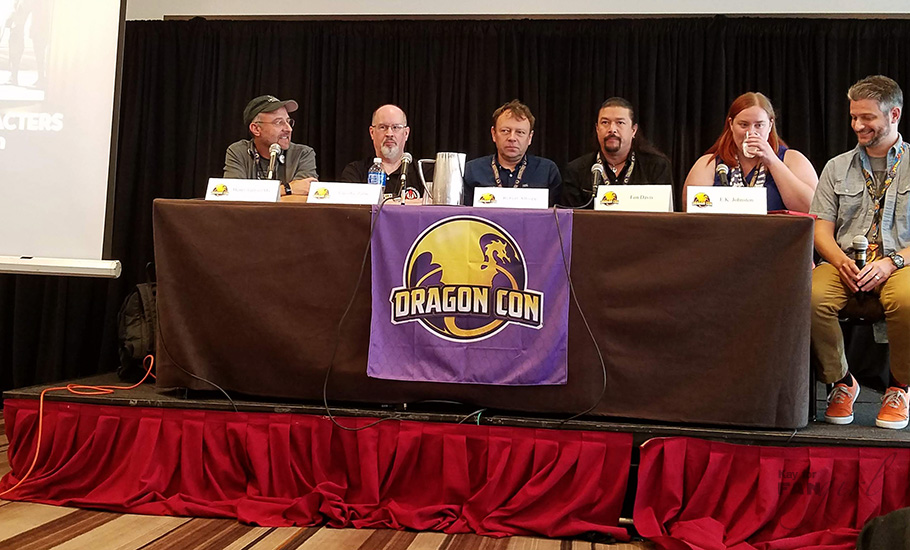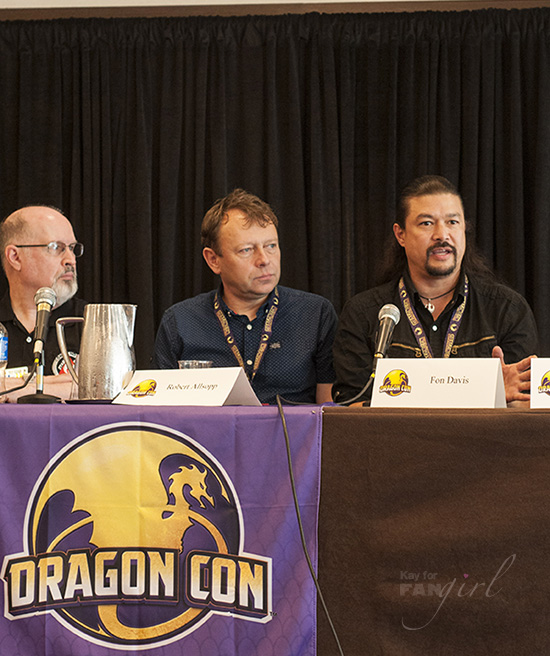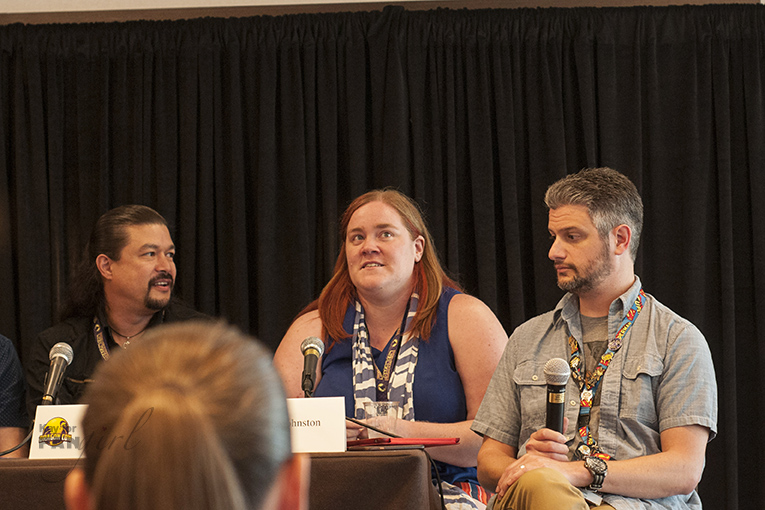Dragon Con Looks at Creating Iconic Characters in Star Wars and Beyond
What’s it like working on iconic characters? And how do creators working in different media approach them? These are some of the questions the Creating Iconic Characters From Page to Screen panel set out to answer as part of this year’s Star Wars track at Dragon Con.
Usually at conventions you get Star Wars panels with guests focused by job type – only authors or only sfx crew for example. So it was really cool to have a panel of people who cross departmental lines plus who’ve worked not only on Star Wars but also other iconic properties.

The line-up included:
Henry Gilroy, known for his work as a screenwriter and developer for Star Wars: The Clone Wars as well as a producer for Star Wars Rebels, has worked on a lot of animation including the Guardians of the Galaxy tv series, House of Mouse, and Batman: The Animated Series.
Timothy Zahn, the creator of Grand Admiral Thrawn and writer of 12 Star Wars novels and various short stories, has also been the author of a couple Terminator books.
Robert Allsop specializes in costumes that are more like props such as the spacesuits in The Martian and has worked on franchises including Star Wars, Doctor Who, and Judge Dredd over the past thirty years.
Fon Davis is a visual effects artist who was a model maker both for the special edition versions of Star Wars’ original trilogy as well as for the prequel trilogy. He’s worked at ILM on the Matrix, Terminator, Mission Impossible, and Jurassic Park franchises and now has his own company.
E.K. Johnston is an author known for speculative fantasy and sci-fi as well as fairy-tale reimaginings. For Star Wars she’s written the YA novel Ahsoka and “By Whatever Sun” for A Certain Point of View. She’s also the author of the upcoming Padmé-centric novel Queen’s Shadow.
Approaches and Inspiration

Moderator Matthew Rushing lead the panelists through a series of questions that dug into their approach, processes, and inspiration. Henry Gilroy talked about starting with taking a look at the pre-existing history for the characters because everybody has expectations based on that information. Fon Davis also said for his work immersion is important – both digging into what has been created and what the story is inspired by. Gilroy gave an example of creating new characters in a pulpy style since Star Wars was built out of cinematic influences like that. Davis emphasized though that the focus has to remain on storytelling even in character design. In his work that could mean telling a robot’s story through its paint job.
Robert Allsop’s work is a little different though. He’s usually given a drawing or design to make come to life. Sometimes they’re so detailed he wonders if the thing exists already and sometimes they’re very loose pencil sketches. A few times on Doctor Who he’s even been given the freedom to sketch out ideas himself.
Each panelist cited different places that they get their inspiration for working on these characters. While Allsop mentioned modern audiences as part of his inspiration, Davis expounded on all that can be galvanized from getting to look through a company like Lucasfilm’s archives. E.K. Johnston half-joked that her inspiration for writing Star Wars is Star Wars.
She went on to explain that the inspiration is cyclical and based on keeping the overall Star Wars story going. Fellow author Zahn spoke of getting to put Padmé in his recent novel Thrawn: Alliances. He’d felt that as a character Padmé had been wasted in the movies but well fleshed out in the cartoon so he looked there to assess her toolbox of skills. This was appreciated by Gilroy because he said when they were developing The Clone Wars TV series George Lucas wanted Padmé to be a “diplomatic action hero”.
Questions and Rules
The moderator also asked the panelists about what questions they ask themselves or others when creating new characters as well as what they stay away from in those situations.
Earlier in the panel Tim Zahn had said when creating characters for his work, his first step is to make sure the character feels like they could have been right off screen in one of the movies. He expounded here that he also takes into account how established characters are going to react to the new character. An example of this is when he watched Rebels he wondered about how some of the rebels would react to Agent Kallus and whether some of them would ever accept him. (Gilroy noted that that was something they considered and explored ideas about but just didn’t have time for in the actual show.)
While working on The Clone Wars Henry Gilroy said he’d ask himself what kind of movies George Lucas liked and then base new characters on characters from them – knowing Lucas would be more likely to approve. For Allsop he asks himself where he’s seen a similar design before. He shared that once while working on Doctor Who he was given a sketch that was clearly inspired by the invisibility helmet in Clash of the TItans. Strangely enough he not only knew what designer had made the original helmet, but he’d actually bought several molds from the man when he retired. Turns out Allsop already owned the original mold for the Titans helmet and was able to use it as a base for the Who design.
When it comes to knowing what to stay away from, Johnston joked that you have to “search your feelings”, but also she prefers to stay away from community analysis while creating. Gilroy talked about the importance of making sure the Jedi in the TV series weren’t superheroes; there are limits to their powers and there has to be purpose to the characters in the story. Zahn agreed about limiting powers, but said knowing what is and isn’t Star Wars at this point is pretty innate for him. There’s a lot that is NOT Star Wars. Davis pointed back to George Lucas wanting all the designs to have inspiration from our world so there was something familiar. He said rules get established in the creation of Star Wars – such as no wheels – but sometimes they later get broken.
Making an Icon and Being a Fan

Perhaps the toughest question of the panel was asking how you make a character an icon. Davis spoke of using iconic shapes to define the character while Gilroy talked about making sure the character has something people can relate to about them. Johnston cited that sometimes a character is only iconic to certain sets of people and spoke of how Enfys Nest from Solo struck a chord with her personally. But ultimately Zahn said all they can do is hope the character resonates with the audience because it’s ultimately up to the audience to decide if a character is an icon.
When it came time to share what they as fans got excited over getting to be a part of, E.K. Johnston spoke of writing Bail Organa while Henry Gilroy mentioned being able to develop Obi-Wan and Anakin in between the movies. Robert Allsop talked about reimagining the look of Judge Dredd and then seeing that look show up elsewhere like in comics. Fon Davis’ reply was similar in that he shared how much he enjoys working on and adding to the original Star Wars characters, but also when the random thing he found on a table and glued to something shows up in detail on a toy.
By the time audience questions rolled around – all the panelists realized they had something else in common. They all had proudly worked on Padmé Amidala. Johnston and Zahn have written her in books. Gilroy worked on developing her for TV. Allsop made wireframes for her hair in The Phantom Menace. And Davis had built the miniature model of her apartment, which sadly does not have a bathroom.
Audience Q&A
Questions from the audience ranged from the consideration of cosplayers when designing costumes (they tend not to and said cosplayers tend to have it harder because their costumes have to hold up longer than production ones) to incorporating the 501st (Zahn borrowed the costuming group’s name for a story and it took off). An inquiry about using setting as character gave a chance for Johnston to talk about Ahsoka trying to isolate herself in her book but repeatedly getting drawn back into things eventually leading to her making decisions truly on her own and without backup for the first time.
As far as favorite expansion moments went, the Certain Point of View book was cited by Johnston as things one person wouldn’t have thought of on their own but 40+ authors and an editor did. For Gilroy there was the conundrum of when Dave Filoni called and told him that George wanted to bring Maul back, when Gilroy felt like George had made it so explicit that he died in The Phantom Menace.
Other questions allowed the panelists to share what else they’d like to work on. Timothy Zahn would like to write about Obi-Wan making a nuisance of himself right after dropping Luke off on Tatooine to draw any attention away from there. Fon Davis wants to work on Tron and he’s hoping saying that works out as well as the last time someone asked. Back then he said Godzilla and he got the call to work on it four days later. Robert Allsop would like to redesign some classic Doctor Who monsters. And E.K. Johnston would like to write a YA Palpatine novel or some My Little Pony.
All photos by Kay. They’d be better if she wasn’t mainly focused on taking notes. :) Please do not republish any of this content without her permission.
- Review: Doctor Aphra, An Audiobook Original (Star Wars) - July 26, 2020
- Review: Bonds of Brass by Emily Skrutskie - April 7, 2020
- Review: The Art of The Rise of Skywalker - March 31, 2020









